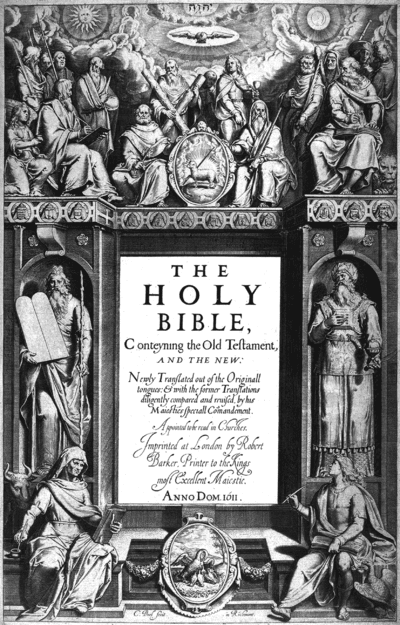King James (the sixth of Scotland and first of England) not long crowned planned a conference for November, 1603, to discuss sundry matters involving the church of which he was now head. Due to an outbreak of plague the Hampton Court Conference in fact met in February, 1604.
The king and his counselors dealt with some complaints from the Puritan element of the church, matters of who should officiate at baptisms (clergy only, thank you), ecclesiastical discipline, and in general put his own imprint on the church Elizabeth created out of the ruin following Henry, Edward VI, and Mary, continuing the English church’s trending toward moderation and inclusivity.
This meeting also led to the king commissioning a new translation of the Bible.
A team consisted of forty-six clergy of the Church of England, and one lay communicant, Sir Henry Savile were selected and set to work. They were organized into six committees, and worked at both universities and Westminster Abbey. Richard Bancroft, then Archbishop of Canterbury served as “chief overseer” for the project.
The new bible was to look to previous translations, the Tyndale Bible, the Coverdale Bible, Matthew’s Bible, the Great Bible, and the Geneva Bible. Scholars have also felt some influences from the Taverner’s Bible and the New Testament part of the Douay–Rheims Bible.
The translators were also all scholars and highly competent in the languages of the Bible, and while mindful of the previous translations, as well as certain “guidelines” from the court, saw themselves as pursuing the best translation that was possible. And pretty much everyone since agrees that they achieved their goal of producing a scholarly and (generally) nonpartisan Bible.
Finally, today, the 2nd of May, 1611, “THE HOLY BIBLE, Conteyning the Old Teſtament, AND THE NEW: Newly Tranſlated out of the Originall tongues: & with the former Tranſlations diligently compared and reuiſed, by his Maiesties ſpeciall Comandement” was published by the King’s Printer.
Within a few years it would come to be called the King James Version of the Bible. And it would remain “the” English language Bible well into the Twentieth century. While not the primary version used in most churches nor in seminaries today, it remains much beloved. And parts, such as the psalms remain the preferred readings in times of distress for many people.
The King James Version is universally acknowledged as a major accomplishment of early modern England, and helped to set the language we know today. The Wikipedia article on the KJV, notes “The Authorized Version has been called ‘the most influential version of the most influential book in the world, in what is now its most influential language,’ ‘the most important book in English religion and culture,’ and ‘the most celebrated book in the English-speaking world.'”
Richard Dawkins, best known as one of the more aggressive new atheists, once observed, “A native speaker of English who has never read a word of the King James Bible is verging on the barbarian.” He’s right.
I learned to read out of a large illustrated King James Bible resting on my grandmother’s lap. It gave me cadences and tropes, not to mention vocabulary that occupy my thinking and my writing to this day.
My gratitude can never be adequately repaid.














